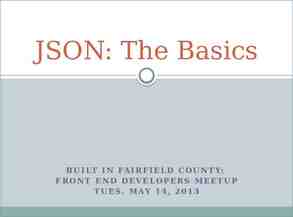The Center for IDEA Early Childhood Data Systems Who’s in Charge of My
44 Slides6.07 MB

The Center for IDEA Early Childhood Data Systems Who’s in Charge of My Data? Protecting Data with Effective Data Governance Denise Mauzy, DaSy Richelle Davis, OSEP Kara Arzamendia, MN Department of Education Jeff Sellers, DaSy August 2, 2017 2017 NCES STATS-DC Data Conference

Increase Understanding of Session Objectives The importance of formal data governance policies and procedures to state agencies ED & MN’s data governance and areas for future work How to utilize the DaSy Data Governance and Management Toolkit and other resources

Seeking Data Governance

Senario: Data Breach Response

Senario: Data Change

Senario: Data Request

Scenario overview from participants

What is Data Governance? Management of availability, usability, integrity, quality, and security of data Organizational process and a structure Establishes responsibility Creation and enforcement of policies, roles, responsibilities, and procedures - DaSy Glossary

Why Focus on Formal Data Governance?

. because this won’t happen.

Formal and Informal Formal Data Governance InformalData Data Governance Governance Data use consistent with purpose and vision Increases – probability of effective data practices – data security – confidence in data and associated processes Supports – Data integration – Improved data efficiency Questionable data quality, security, and usefulness Difficulty managing data and processes Unclear data roles and responsibilities of staff (internal and external) Inappropriate data sharing Unprepared for data integration opportunities Increased risks with staff turnover

Data Governance: It is Needed at All Levels Federal State District Local Program

Data Governance at the Federal Level Richelle Davis, – Office of Special Education Programs

Data Governance at ED EDFacts Data Governance Board (EDGB) Established in 2006 intra-agency council with representatives from multiple program offices at ED resolves issues and creates the policies needed to manage ED’s PreK–12 asset of education data

EDGB Mission The EDGB supports data quality and data integrity by identifying common standards, developing operating policies, and implementing processes for managing data. EDGB work is leading to more informed and confident data use. EDGB accomplishes this by – Inter-office coordination – Timely and effective resolution of data issues – Clear and organized documentation of how data issues are resolved

Why Have Data Governance at ED? Fosters ED-wide data-driven decision-making Resolves data ownership issues Leads to information sharing across program offices Proactively manages data vulnerabilities Improves the quality of data collection, reporting, and usage

Benefits of Participation in EDGB: Facilitates coordination across program offices Leverages knowledge, expertise, processes, and products from other program offices Provides opportunities for IDEA and CWDs to be considered when developing data-related policies and procedures Documents data-related decisions, policies, and processes

EDFacts Data Governance Board Resources Under “Key Information about EDFacts” Section at: https://www2.ed.gov/about/inits/ed/edfacts/index.html

Data Governance at the State Level Kara Arzamendia, – Minnesota Department of Education

Scope of Governance Spans Data Lifecycle

MDE Future State Components MDE Future State Components

2 Several Themes Emerged Data Structure Data and Analytics Governance Reporting and Analysis Reference and Metadata

Sample Roadmap for Data Management Areas requiring governance Charter Solutions, Inc.

Where do we start? Data Governance Create policies & procedures Assign roles & responsibilities Begin conducting regular meetings Implement a reference data management tool Provide training on roles & responsibilities and reference data management tool

Define Governance Structure & Processes Day to day governance activities Key roles Escalation & issue resolution processes Develop routine cadence as part of the project “Creates leadership, ensures structure & direction” Data Consumers

So Where Do We Start? Start small, don’t try to tackle everything at once Pick a subject area or analytics challenge to use as the “Pilot Project” High value opportunity High visibility Use to define governance activities & processes Use to elicit all the roadmap components

Use Pilot Project to Define Governance Activities What process are we following? Follow the data management activities roadmap Create governance process & artifacts as we go Review governance topics & recommend process or policy Review, clarify, recommend VPK Proj ect Identify potential governance implications Make final policy decision Identify, escalate

Form the Team & Define the Roles Project sponsor Data domain expert – data steward Data design & data movement resource Reporting analyst Small group of users to validate results Just enough roles Only what is needed May be the same person Cross-functional team

Challenges 1. Cross agency work: institutionalizing data governance into the culture 2. Managing expectations: Maintain momentum through this developmental period 3. Silos and bad habits: benefits to a group based process; taking ownership on the work 4. Communication: constant feedback loops so everyone is aware of what everyone else is doing

Next Steps Identify the data governance coordinator Prioritize goals from the current efforts – VPK pilot – Categorization system Formalize the Data Management Committee Create a data governance policy Form subgroups or leverage existing subgroups to do specific work

DATA GOVERNANCE TOOLKIT

Table of Contents 1. 2. 3. 4. 5. 6. 7. 8. 9. 10. Introduction Purpose, Structure, Process Charter Data Breach Response Data Security and Access Data System Changes Data Quality Data Requests Electronic Communications Public Reporting Resources

Each Toolkit Section Contains

Overview A short description of the data governance topic and how it applies to Part C and Part B 619 programs.

Considerations Questions to help programs draft policies and procedures for the topic

Template An editable and prepopulated template with language to expedite writing topical policies and procedures.

Toolkit Documents and Supports Formal Data Governance with Creation of Polices Policies, and Procedures to support the policies, are at the center of data governance and management

Data Governance P&Ps Support: Common data understanding and consensus Consistent practices Record historical processes Defined work Increased productivity A standard for evaluation “The Lottery” scenario (staff turnover)

TOOLKIT ONLINE DEMO

Other Data Governance Resources SLDS Data Governance Manual Rubric: https://nces.grads360.org/#communities/pdc/documents/13499 SLDS Best Practices Brief: P-20W Data Governance: https://nces.grads360.org/#communities/pdc/documents/2717 SLDS Early Childhood Integrated Data System Guide: https://nces.grads360.org/#communities/pdc/documents/8968 Privacy Technical Assistance Center (PTAC) Data Governance and Stewardship: http://ptac.ed.gov/sites/default/files/issue-brief-data-governance-a nd-stewardship.pdf

Common Education Data Standards https://ceds.ed.gov/dataGovernance.aspx

Discussion

Thank you! Visit the Toolkit at: http://dasycenter.org/data-governance-management-toolkit/ Visit the DaSy Data Governance Framework at: http://dasycenter.org/resources/dasy-framework/data-manag ement/ Visit the DaSy website at: http://dasycenter.org/ Like us on Facebook: https://www.facebook.com/dasycenter Follow us on Twitter: @DaSyCenter

Thank you The contents of this presentation were developed under a grant from the U.S. Department of Education, # H373Z120002. However, those contents do not necessarily represent the policy of the U.S. Department of Education, and you should not assume endorsement by the Federal Government. Project Officers, Meredith Miceli and Richelle Davis.






